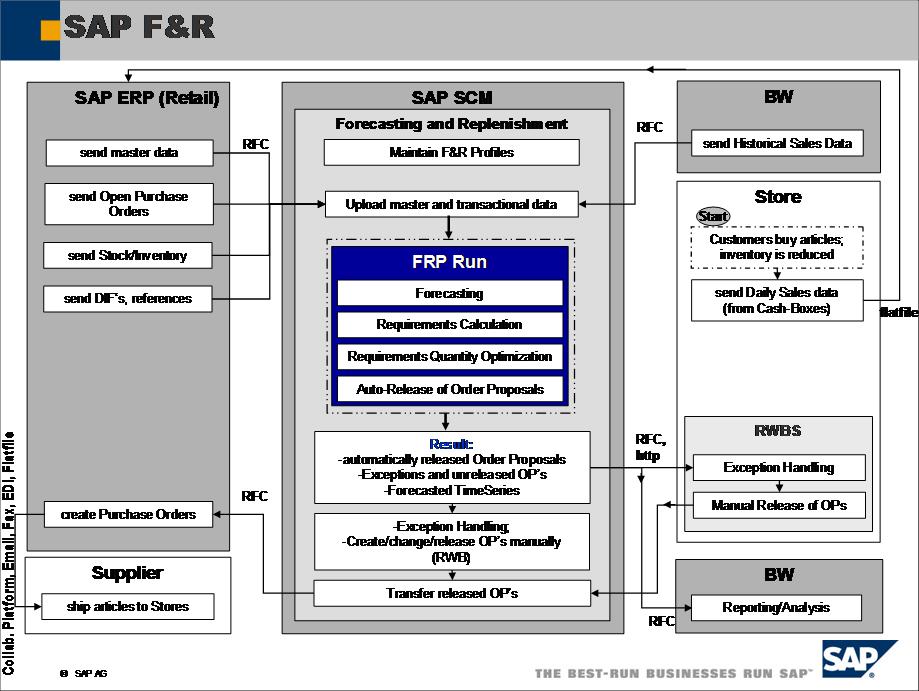What is SAP F&R (Forecasting and Replenishment)?
SAP F&R (Forecasting and Replenishment) is a software solution designed to help retailers optimize their supply chain operations. It provides advanced demand forecasting and inventory optimization capabilities, allowing retailers to reduce inventory costs, improve product availability, and increase sales.
SAP F&R helps retailers generate accurate demand forecasts using advanced algorithms and statistical models based on historical sales data, promotions, and other factors. It also helps retailers optimize inventory levels by determining the optimal inventory levels for each product and location, taking into account factors such as lead times, service levels, and safety stock. This helps retailers avoid stockouts and overstock situations.
In addition, SAP F&R can automatically generate purchase orders or transfer orders based on the demand forecasts and inventory levels, helping retailers to automate replenishment processes and improve supply chain efficiency. The solution also provides collaboration tools for retailers to work with suppliers on demand planning and inventory management.
Overall, SAP F&R is a powerful solution for retailers looking to improve their supply chain operations and increase sales by optimizing their inventory management processes.

The Most Important Features of SAP F&R
SAP F&R (Forecasting and Replenishment) is a software solution designed to help businesses optimize their supply chain management by accurately forecasting demand and automating the replenishment of inventory.
The most important feature of SAP F&R is its advanced forecasting capabilities. With the ability to analyze historical sales data, market trends, and other relevant factors, SAP F&R can generate highly accurate demand forecasts. These forecasts are used to optimize inventory levels, reduce stockouts, and improve customer service levels.
In addition to forecasting, SAP F&R also includes features such as automatic replenishment, inventory optimization, and analytics and reporting. Together, these features help businesses achieve a more efficient and effective supply chain, leading to reduced costs, increased profitability, and improved customer satisfaction.
Who Should Prefer to Use SAP F&R?
SAP F&R is a software solution that is best suited for businesses that have a complex supply chain and a large amount of inventory to manage. Specifically, companies that operate in the retail, wholesale, and consumer goods industries are likely to benefit the most from SAP F&R.
In particular, companies that have a large number of SKUs (stock-keeping units), multiple distribution centers, and high demand variability are ideal candidates for SAP F&R. Moreover, businesses that have a global presence and operate across multiple regions or countries may find SAP F&R particularly useful, as it can help them manage their inventory and supply chain more efficiently and effectively across multiple locations.
Overall, any company that needs to manage its inventory and supply chain more efficiently and effectively may benefit from using SAP F&R, but it is particularly well-suited to companies in the retail, wholesale, and consumer goods industries.
How to setup SAP F&R?
Setting up SAP F&R (Forecast and Replenishment) involves several steps, including system installation, configuration, and testing. Here are the general steps you can follow:
System Installation: The first step is to install the SAP F&R software on your server or local machine. You can obtain the installation media and instructions from SAP or an authorized partner.
Configuration: Once the system is installed, you need to configure it to meet your specific business requirements. This includes defining organizational structures, setting up planning areas, configuring master data, and defining planning parameters.
Master Data Management: Master data management involves creating and maintaining data such as product information, locations, and suppliers.
Data Integration: Integrating data from various sources such as ERP systems, POS systems, and other data sources is critical to the success of an F&R implementation. You need to define the interfaces between these systems and SAP F&R.
Planning: SAP F&R uses sophisticated algorithms to generate demand forecasts, optimize inventory levels, and generate replenishment plans. You need to define planning strategies that meet your business requirements.
Testing and Validation: Once the system is configured, you need to test it thoroughly to ensure that it meets your business requirements. You can use sample data to simulate real-world scenarios and validate the system's performance.
Training: Finally, you need to train your users on how to use SAP F&R effectively.
Overall, setting up SAP F&R requires a combination of technical expertise and business knowledge.
How to Integrate SAP F&R with Other Systems?
Integrating SAP F&R with other systems is an important step in maximizing the benefits of the software solution. There are several ways to integrate SAP F&R with other systems, including:
- SAP Integration: SAP F&R can be integrated with other SAP systems such as SAP ERP and SAP SCM using SAP PI (Process Integration). This allows for seamless data transfer between systems and ensures consistency and accuracy of data across the enterprise.
- Application Programming Interfaces (APIs): SAP F&R provides APIs that allow other systems to connect and exchange data. APIs can be used to integrate SAP F&R with other systems such as CRM, WMS, and TMS.
- File-Based Integration: SAP F&R can also be integrated with other systems using file-based integration. Data can be exported from SAP F&R in a specific format (such as CSV) and then imported into other systems.
- Middleware: Middleware such as SAP Cloud Platform Integration can be used to integrate SAP F&R with other cloud-based systems. This approach allows for real-time data exchange between systems and supports a wide range of integration scenarios.
Regardless of the integration approach chosen, it is important to ensure that data is exchanged accurately and efficiently between systems. This requires careful planning, testing, and monitoring to ensure that the integration is successful and that data is synchronized between systems in a timely manner.
Introducing Our SAP F&R Experience and Solutions!
You can contact us or request a demo to get more detailed information about our successful SAP F&R projects and experiences with different processes and different customers.